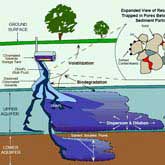
- +44 (0)1953 454540 enquiries@stuartwells.co.uk
Loading ...


DNAPL is a liquid that is denser than water and does not dissolve or mix easily with it.
In the presence of water it forms a separated phase from the water.
Releases of Dense Non-Aqueous Phase Liquids (DNAPLS) to ground and groundwater presents a significant challenge to site remediation as relatively small volumes can result in extensive contamination. Recovery of the product can be extremely difficult.
DNAPL is a liquid that is denser than water and does not dissolve or mix easily with it. In the presence of water it forms a separate phase from the water and generally pools on impermeable layers such as clay. These pools serve as a long term source for dissolved phase contamination.
Effective remediation of DNAPL contaminated sites requires a combination of more than one treatment technology. Generally a combination of chemical oxidation and pump and treat are proven to bring the best results. Careful selection of materials and supervised installation of injection and abstraction wells is crucial to success of the project.
Monitoring of the ground conditions before, during, and after treatment, especially of the microbial population, will show how the contaminant degradation has been affected by the treatment.
The most common form of DNAPLs are chlorinated solvents.
Copyright © 2024 Stuart Wells Limited, all rights reserved.